Samsung Gear 360 (2017) Review
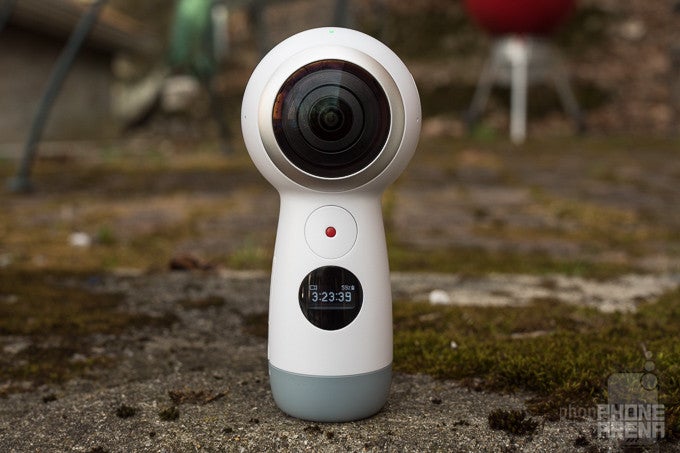
Introduction
Technology has a funny way of operating in cycles, and while newer devices are always arriving to replace the old, wait long enough and you might just see trends circling back to where they began. Take mobile video recording, for instance. Back in the late 2000s, pocket camcorders like those sold under the Flip brand were convenient ways to easily record relatively high-quality video.
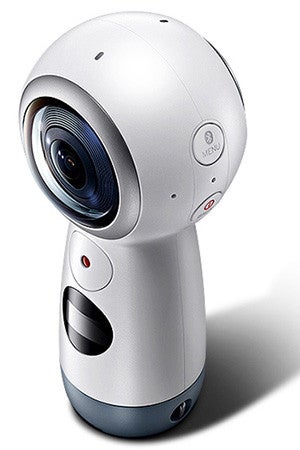
Recently, however, we've been seeing a new wave of interest in personal, portable camcorders, with the emphasis now on producing panoramic 360-degree content ready to be shared online on viewed with a virtual reality headset. While the move back to carrying around a second device may feel like a reversal of progress, it's actually a pretty pragmatic move, and considering the big fish-eye lenses we need to capture insanely wide-field-of-view video, and how you have to pair two of these units front-to-back for full 360-degree coverage, it makes a lot of sense to implement this as a new device, rather than drastically change the look and shape of smartphones.
Last year, we saw companies like LG and Samsung launch their first-gen 360-degree cameras, and while LG seems to be content with what it's already delivered, Samsung's already back to the drawing board with a new Gear 360. Is this revised camera a step in the right direction? Has Samsung fixed some of the issues we had with the first-gen Gear 360? And maybe most importantly, is this new hardware something you're going to want to pick up for yourself? Let's take a look at what you can expect from the 2017 Samsung Gear 360.
Design
A smaller, more portable Gear 360 shines at hand-held operation

The first-gen Gear 360 looked like few other cameras we'd seen before, a bulky two-sided “eyeball” of a camera, with its own convenient mini tripod. It felt substantial and rugged, and offered enough hardware controls that you could operate the device independently of your smartphone with little difficulty.
The new Gear 360, meanwhile, comes across more as a Gear 360 Mini. For starters, the main “ball” part of the camera is much more compact than last year, instantly making the Gear 360 a lot easier to carry around in your pocket – so you have it ready to use on a moment's notice. Samsung helps accomplish that by moving some of the camera's guts to a new base cylinder that now extends beneath the main camera hardware.
Right away, that delivers some important usability improvements. For one, it gives the Gear 360 a proper grip, letting you easily manipulate and maneuver the camera to get the shot you're looking for. And with a flat bottom, it also doubles as a stand, so you can set the Gear 360 in one place and have it shoot footage unattended.
Now admittedly, this new base feel a little less stable than last year's fold-out tripod, but Samsung tries to mitigate that with a slide-on rubber O-ring that effectively widens the base and adds some extra tip-resistance. It's far from the most graceful solution we've ever seen, but it does seem effective, and the benefit of that built-in handle tends to outweigh issues with stand stability.
Having this new grip also allows Samsung to relocate the Gear 360's shutter button and tiny OLED display from that awkward up-top placement to right on the unit's side, in easy reach of your thumb. Samsung also moves the microSD slot down here, as well as a now-exposed USB port; it used to be that the Gear 360's charging port was hidden behind a water-resistant flap, but it's now out in the open, ready to be accessed even while you're shooting video.
Like the original Gear 360, this new model is IP53 dust and water resistant, and while that means the camera can survive an unexpected downpour, actual submersion is out of the question; you won't be using this 360 camera underwater.
Really, though, for all the changes Samsung's saw fit to implement for its second-gen 360 camera, easily the most important is improving the Gear 360's portability. The new design is substantially more convenient to carry around, and that makes it all the more likely that you'll have the camera on-hand when you actually need it to record an interesting moment.
Ease of use, companion apps and phone compatibility
A familiar interface returns on both phone and camera ends, and we still crave broader Android support
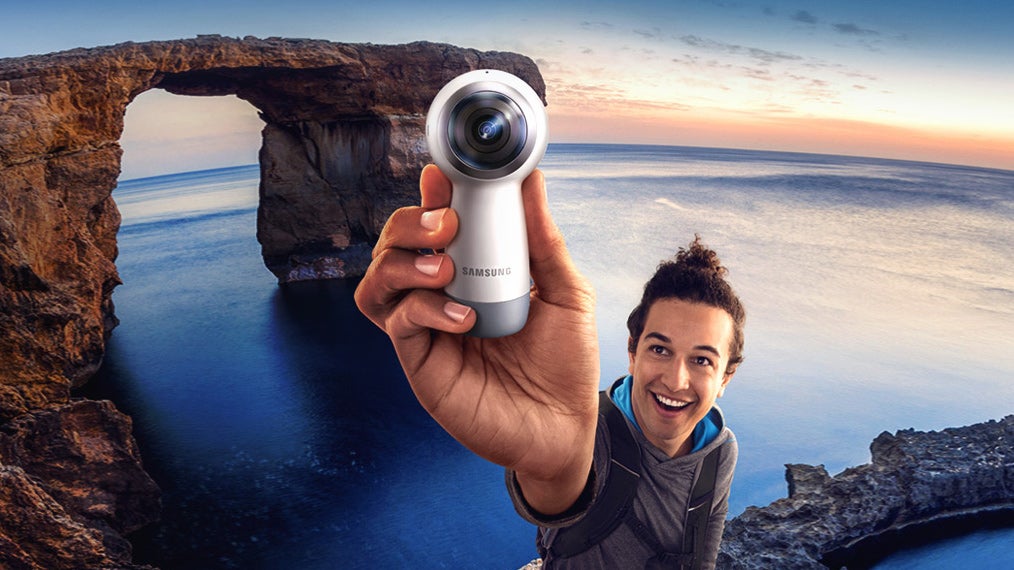
Operating the new Gear 360 isn't so much different from how you'd interact with last year's model. You choose your shooting mode (video, photo, time-lapse video, looping video, or landscape HDR photo) and set camera options (like which or both lenses to have active, and video/photo resolution) with a series of three hardware buttons: menu, back, and shutter/select. All the while, you can see where you are in the camera's menu structure by way of a tiny black-and-white OLED screen.
Sometimes it can be annoying to have to cycle past all those options after you accidentally miss the one you were going after, and it can take a bit of digging into nested menus to find the one you're looking for, but all of that gets much easier with practice. And once you have your options set to your liking, simply choosing a mode and starting to record is a breeze.
Just as it was last year, phone compatibility is still a big sticking point, and it's easily the biggest issue we have with the Gear 360. The good news is that Samsung's improved handset support for this new camera, extending access to iOS phones and a couple non-flagship Galaxy models.
But that still excludes the vast, vast majority of Android phones, including those from every other manufacturer. If this were an accessory like the Gear VR, where the phone itself is an intimate part of the user experience, and things like handset hardware dimensions are critical, we'd be a lot more understanding, but there doesn't seem to be a great reason why Samsung's refusing to play nicely with everyone else out there.
Maybe having complete control over both the hardware and software sides of the equation makes it easier to do things like setting up the Wi-Fi Direct connection your phone uses to transfer data from the Gear 360, but that there isn't at least some workable solution (even if of more limited functionality) for non-Samsung Android phones is nothing short of unforgivable in today's smartphone climate. Users tend to insist on broad compatibility, and it's shockingly arrogant of Samsung to act otherwise. That the company saw fit to extend support to Apple phones but not other Android models only serves to rub salt in those wounds; to call it annoying would be an understatement.
Sensors, lenses and specs comments
Samsung's dual-lens fisheye system returns in a revised, much more compact package
Not all progress is obvious, and much like the evolution of cameras on smartphones themselves, the sensors on this new generation of Gear 360 aren't interested in some pointless race to new megapixel heights. Instead, we see Samsung dramatically downgrade sensor resolution, moving from a pair of 15MP cameras on the original Gear 360 to the dual 8.4MP cameras in this new edition. Somewhat counter-intuitively, despite that resolution drop, the camera's top video recording option is now higher-res than before, moving from 3840 x 1920 to the slightly more pixel-dense 4096 x 2048. That improvement doesn't arrive without a cost, though, as while the former could be filmed at 30 frames per second, the new max res tops out at 24fps.
The more significant impact there comes from the effect on still-image capture, dropping from 30MP (when both cameras are in use) to just 15MP And if you're shooting one-lens, the resolution tops out at a tepid 3MP; what is this, 2005?
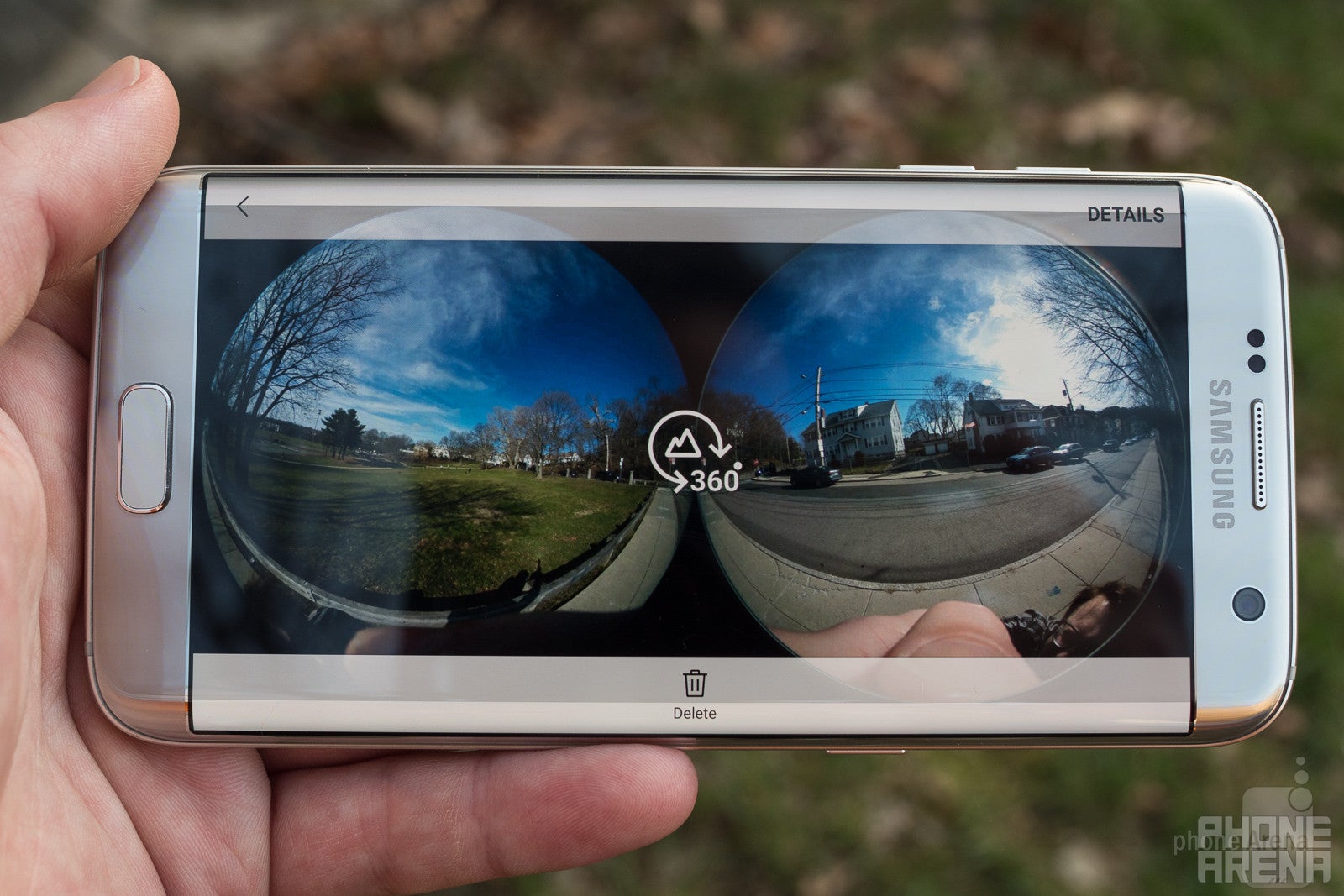
Honestly, though, we're already seeing a fair amount of noise (and corresponding loss of fidelity) when zooming in to 100%, so we're not exactly craving the ability to see that noise in finer and finer detail. For the vast majority of users, these new sensors are more than high-res enough to capture the footage they need, and the benefit we enjoy in terms of improved Gear 360 portability helps ease tensions further. We'll concede that moving to larger sensors would definitely help (and offer more leeway for higher-resolution shots, as well), but considering the Gear 360's market placement, we can understand why Samsung made the decisions it did.
Once again, Samsung employs a pair of fish-eye lenses to capture every angle around the camera – and then stitch those two halves together in software. The effect tends to work well at reasonable distances, though objects that are very close to the Gear 360 (within a couple feet) run the risk of stitch-related distortion.
Image quality
Image resolution takes a big hit, but it doesn't have a pronounced impact on our ability to enjoy the Gear 360
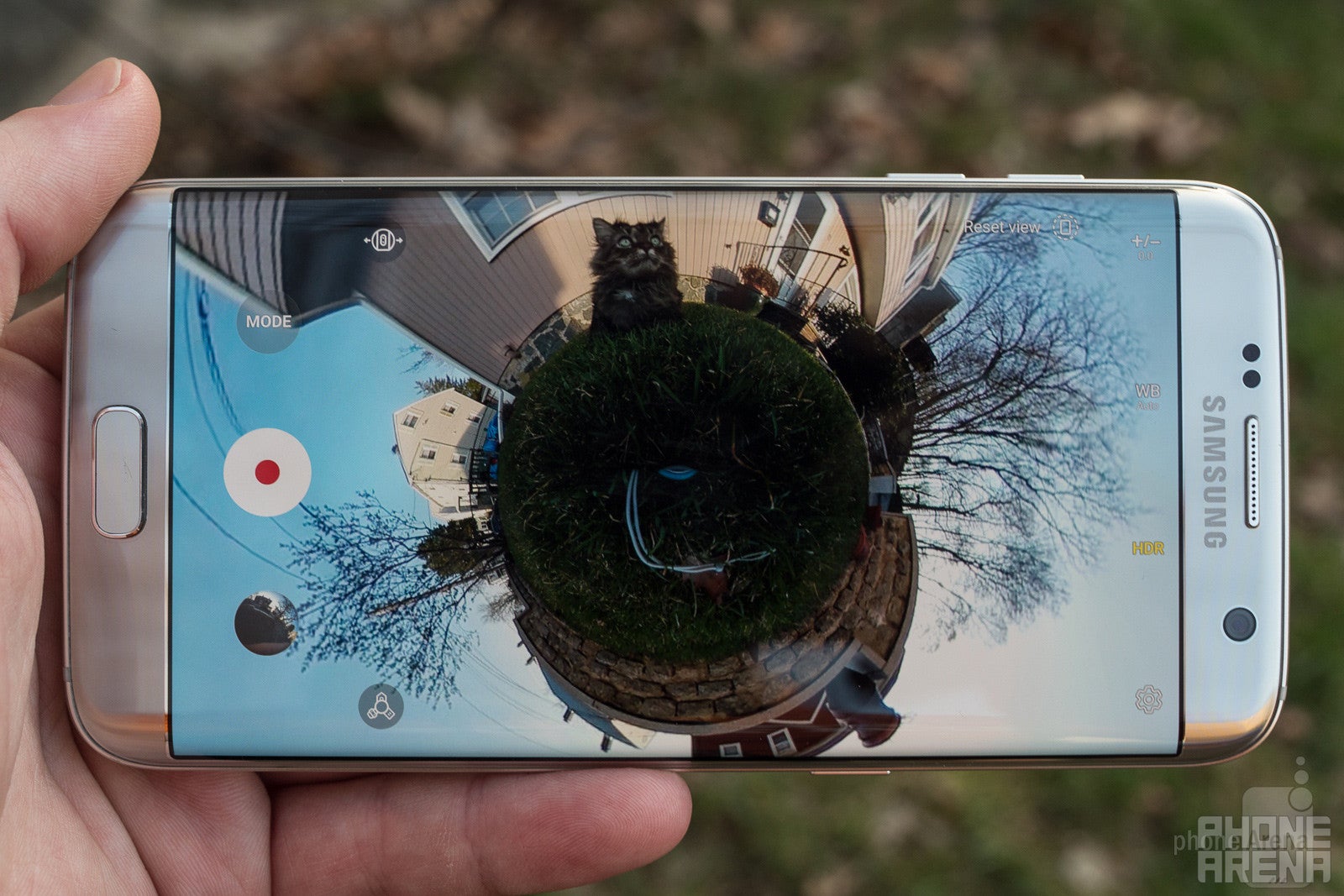
When you're creating content with a device like the Gear 360, you have to be aware of certain sacrifices inherent to the hardware. Rather than simply using an image sensor to record the light directly in front of the camera, we're using some big lenses to draw in light from every angle – and cramming all that data onto a standard image sensor results in lower fidelity than you're likely used to.
That means that even moderately distant objects tend not to be super-clear, nor is every area around the camera captured with the same level of detail. And when you're rendering 360-degree footage during playback, there's lots of computational overhead, such that video can appear quite jerky if you try to push the resolution higher than your system can handle.
But that's nothing new to this year's Gear 360, and so long as you go in aware of the kind of content it can record, there's no reason to be unhappy.
Check out the 360-degree images here
When first reviewing the Gear 360, we were impressed with how good a job it did (compared to LG's camera, at least) at stitching together the two halves of its video. Once again, that's largely the case here. We say “largely” because there are still problems when really close up to the camera – and we're not sure there's much to do about that. But take a step back, and things look much, much better. Sometimes, though, the camera has a habit of over-correcting itself, shifting the two halves of its video back and forth as the Gear 360's software attempts to do a better job at eliminating seams. We also see some of the same old problems with exposure, where one side of the camera is better lit than the other – and things like background walls or the sky go through abrupt brightness changes.
How to save and upload 360 content
Sharing options are plentiful and easy to use, but the export process still feels clunkier than it needs to be
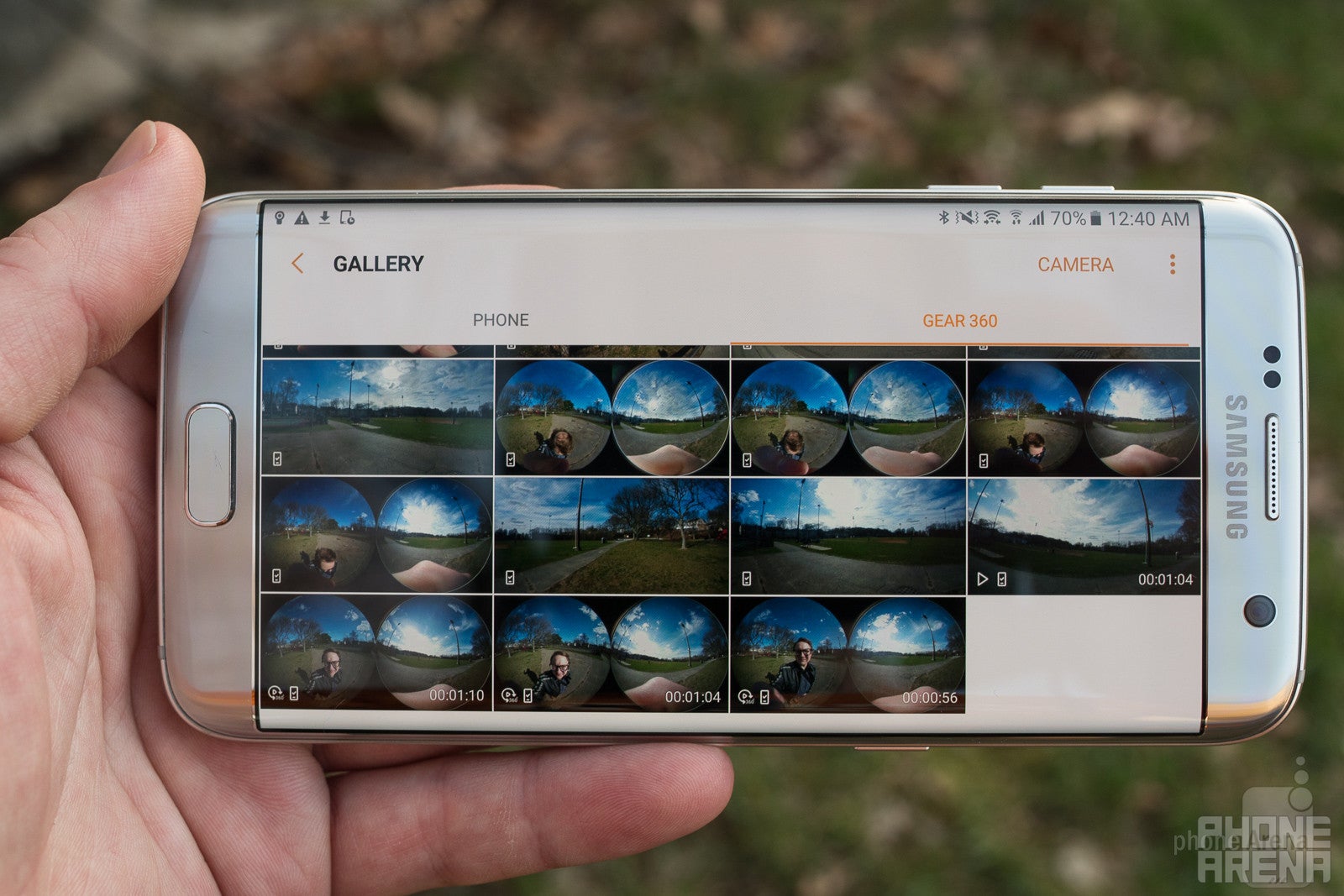
Samsung once again goes with high-efficiency H265 compression for recording Gear 360 videos. In theory, that's a great move, but software support for H265 isn't nearly as widespread as the more popular H264. Perhaps as a result, when you export videos through Samsung's Gear 360 app, they're transcoded to H264 for your phone.
While that makes the videos easier to work with, it also greatly increases file size. For instance, we recorded a short clip using just one of the Gear 360's lenses, resulting in a widescreen 1920 x 1080 H265 video, coming in at around 64MB. But when saving that same video from the Gear 360 to a Galaxy phone, Samsung's app doubled the file size to 124MB while recompressing in H264. As a consequence, if you're looking for the best video quality and smallest file sizes (and you're shooting one-lens, so you don't need any post-processing stitching), you might just be better off pulling the Gear 360's microSD card and offloading your videos manually.
This isn't helped by slow transfers from Gear 360 to phone. Sending a one-minute video from the camera to a Galaxy S7 edge handset took over a minute and a half – and it's never good when transferring footage takes longer than originally recording it. And while the situation seems improved compared to last year, both the phone and the Gear 360 itself can get a bit hot while transferring (and recompressing) files.
New for this year's Gear 360 is the ability to live-stream footage over YouTube, Facebook, or Samsung's own Gear VR service. We took it for a spin using an early release of Samsung's Gear 360 software, and while the feature did work, it wasn't without a few hiccups here and there. Those include issues juggling multiple YouTube accounts, and problems trying to share Gear VR streaming links via text message. We fully expect to see these bumps ironed out soon, as the ability to stream live in full 360-degree panorama is a big draw of this new hardware. Just make sure you're running your phone's latest system software; Android streaming is restricted to Nougat only.
Battery life
Even with battery downgrades, the new Gear 360 comes well equipped for on-the-go operation
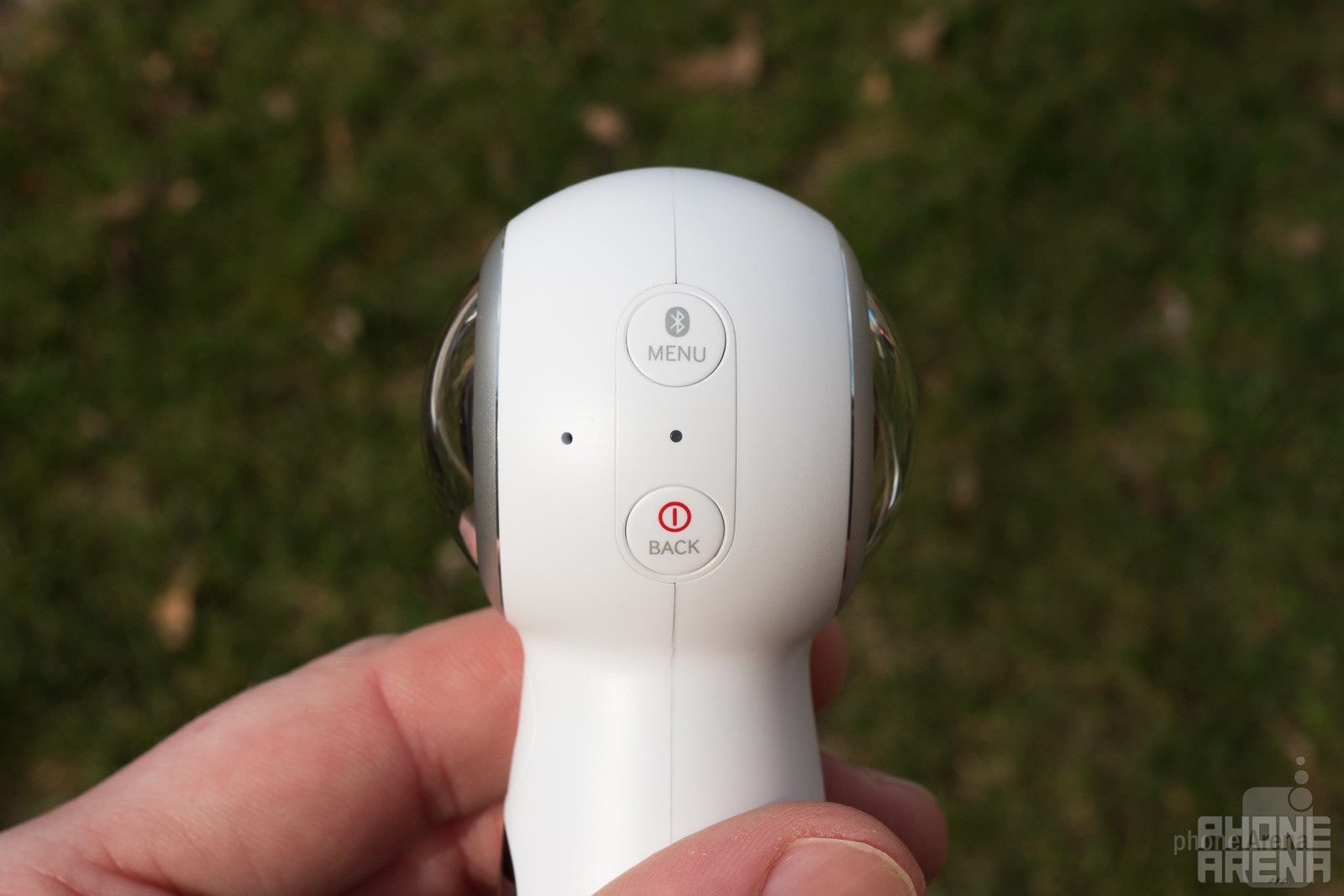
Compared to last year's Gear 360, this new model makes a few sacrifices when it comes to its battery. For one, it's fourteen percent lower capacity, now measuring in at 1,160mAh. It's also no longer removable, and while we doubt many users were swapping out batteries in the middle of the day, that was still a nice option to have, especially if you were out shooting a ton of footage.
On the plus side, the Gear 360's charging port is now fully exposed; it used to be a micro-USB port hidden under the camera's waterproof flap, but now it's a USB Type-C port that's accessible without compromising waterproofing. That makes it possible to keep the camera plugged into an external power source while you're using it – a huge advantage if you intend on doing any lengthy streaming.
But even without external power, the Gear 360 lasts a decently long time on a charge. We carried around the camera for a weekend, shooting a variety of minute-long video clips throughout the day, as well as a number of still pics, and battery life was still north of 60 percent. With heavier usage, you might run into a few issues, but the battery size seems more than adequate for casual filming.
At least, that's the case for actually recording video – but the Gear 360 also chews up battery while wirelessly exporting its footage, and sometimes quite a bit. The good news there is that's it's a lot easier to have your Gear 360 plugged in while exporting, but it's still an issue worth being aware of: this camera burns though its battery at both ends.
Conclusion
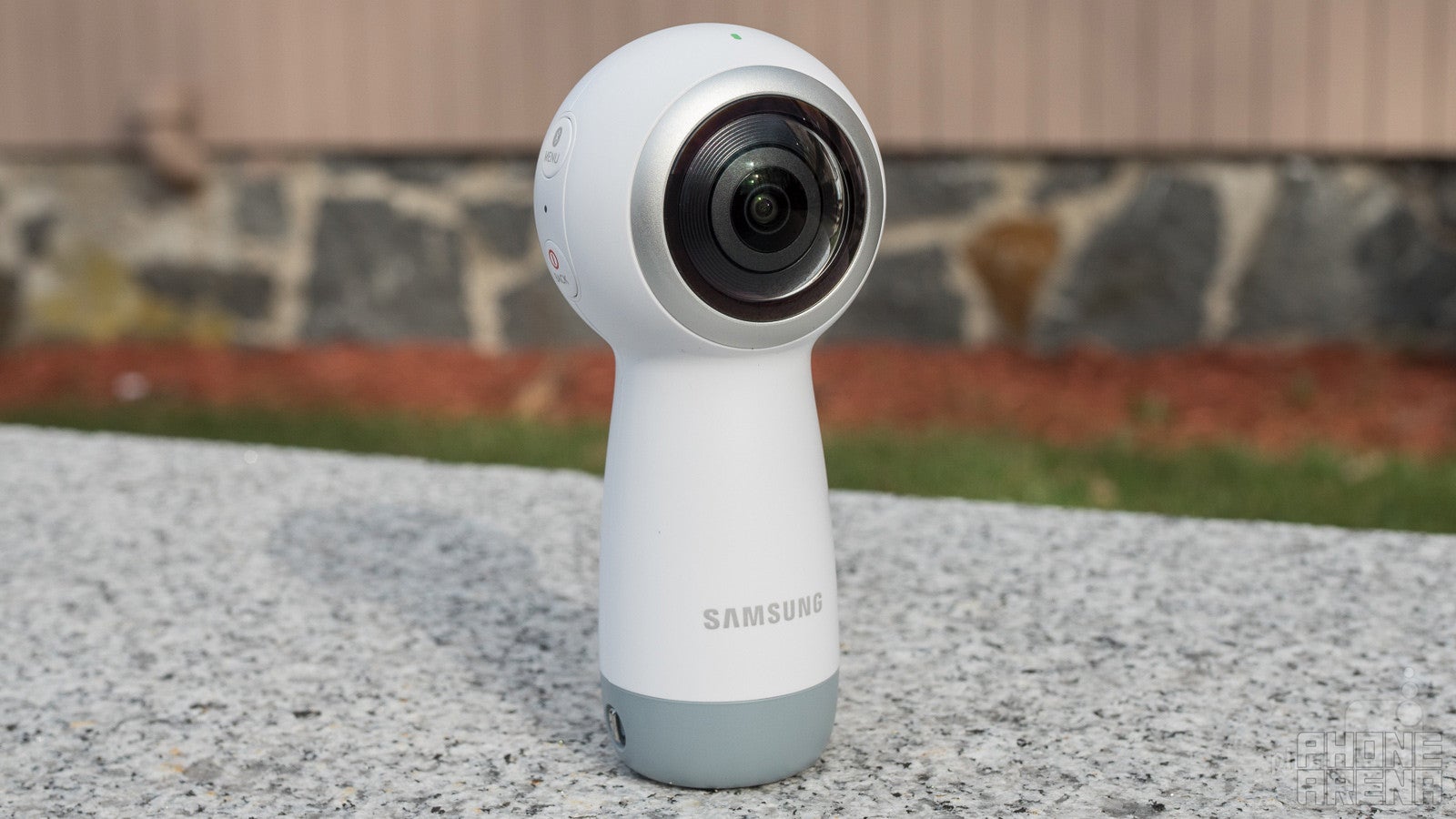
There's little denying that the new Gear 360 is a lot of fun: it produces footage that is difficult or impossible to reproduce with conventional camera hardware, makes sharing that footage with friends easy, and is hugely more convenient to carry around and operate than the first-gen Gear 360.
Samsung also delivers improvements in terms of functionality with live-stream support, as well as powering the camera, by way of the now-external USB port. That said, the 2017 Gear 360 feels more like a new shell around the original device than a fully-baked next-gen product. For as much satisfaction as we got out of using the hardware, we still found ourselves wondering about the possibilities of higher-fidelity imagery, less restrictive compatibility with non-Samsung Android devices, and the kind of thorough ruggedization and waterproofing that would elevate the Gear 360 to full action-cam status.

Ultimately, though, it's going to come down to pricing. Let's face it: few of us really need a camera like this, and it's hard to shake the feeling of it being a kind-of gimmicky extravagance. Luckily, it's a very fun one, but an affordable price can go a long way towards convincing shoppers to drop some coin on such a device. Last year, the first Gear 360 was seriously on the expensive side, launching at around $350.
With a new, smaller build, as well as lower-res cameras, will this new version arrive at just a fraction of that price? That's a very good question, and one we don't have the answer for just yet. We're also curious to get a final look at the latest Gear 360 software, having run an early version that supports this new hardware.
But as we wait to learn the rest of those details, we're still pretty darn enthusiastic about what Samsung's managed to put together here. 360-degree filming may still be far from mainstream, but the new Gear 360 sure feels like a definite step in the right direction.










Things that are NOT allowed: